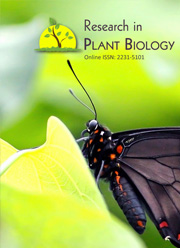Taxonomic significance of leaf architecture in the genus Basella Linn. in Nigeria
DOI:
https://doi.org/10.25081/ripb.2023.v13.8576Keywords:
Architecture, Areoles, Diagnostic, Druses, VeinletsAbstract
This study seeks to use the leaf architecture as a taxonomic tool for members of the genus Basella Linn. in Nigeria, namely, B. rubra Linn., B. alba Linn., B. cordifolia Lamk. and a form, B. alba round because the taxonomy of the genus Basella Linn. is not clear and there is no information on the leaf architecture of the genus. For studies of the venation pattern of the leaves, sizeable portions were taken from the standard median portion of mature leaves. Cleared leaves were stored in 50% alcohol for anatomical studies. Leaves were stained in Safranin O for 3 minutes and counterstained in Alcian blue and then were rinsed in water to remove excess stain. Stained cleared leaves were treated in serial grades of alcohol for differentiation and dehydration. Stained materials were mounted in dilute glycerol for microscopic examination. Photomicrographs were taken with the aid of 3013 ACCU-SCOPE Trinocular Microscope with Digital Camera. The areolar area was calculated from the length and breadth of the areoles measured using a micrometer inserted into the microscope eyepiece. Basella species have common generic features. Areoles are closed in B. rubra but others have veinlet endings. The area of areole is diagnostic because in B. rubra the area is 305,370±1808.91 μm2; B. alba is 501,796.75±3217.38 μm2, B. cordifolia’s area of areole is 396,394.75±2670.67 μm2 while that of B. alba round is 540,058.75±3702.28 μm2. The arrangement of druses in the areoles is also diagnostic.
Downloads
References
Adenegan-Alakinde, T. A. (2014). Taxonomic Evaluation and Ethno-botanical Studies of the Genus Basella Linn. (Basellaceae) in South western, Nigeria. Unpublished Doctoral Dissertation. Obafemi Awolowo University.
Adenegan-Alakinde, T. A., & Jayeola, A. A. (2015). Leaf and Petiole Anatomical Studies of the genus Rhizophora Linn. in Nigeria. International Journal of Current Science, 18, E125-135.
Adeniran, S. A., Kadiri, A. B., & Olowokudejo, J. D. (2020). Taxonomic significance of some leaf anatomical features of the species of Annona Linn. (Annonaceae ) from Nigeria. Ife Journal of Science, 22(1), 101-112. https://doi.org/10.4314/ijs.v22i1.11
Buot, I. E. Jr. (2020). Leaf architecture as promising tool in confirming identity of a confusing plant taxa. Journal of Nature Studies, 19(1), 134-143.
Colombo, P., Spadaro, V., & Raimondo, F. M. (2007). Morpho-anatomical analysis of Viola tineorum and V. ucriana (Violaceae) endemic to the mountains around Palermo (NW-Sicily). Bocconea, 21, 233-247.
FAO. (2010). The Vegetable sector in Thailand: A Review. FAO Corporata Document Repository.
Fortunato, R. H., Varela, B. G., Castro, M. A., & Nores, M. J. (2017). Leaf venation pattern to recognize Austral South American medicinal species of cow’s hoof’ (Bauhinia L. Fabaceae). Revista Brasileira de Farmacognosia, 27(2), 158-161. https://doi.org/10.1016/j.bjp.2016.10.007
Hickey, L. J. (1979). A revised classification of architecture of dicotyledonous leaves. In C. R. Metcalfe & Chalk, L. (Eds.), Anatomy of the dicotyledons; Systematic Anatomy of the leaf and stem, with a brief history of the subject (pp. 25-39) Oxford, England: Clarendon press.
Hutchinson, J., & Dalziel, J. M. (1958). Flora of West Tropical Africa. Published on behalf of the Government of Nigeria, Ghana, Sierra Leone and the Gambia by the Crown Agents for Oversea Governments and Administration Millibank London.
Lima, M. P. S., Soures, A., Sousa, J. L. R., Carvalho, M. S., Porto, J. M. P., & Nraga, F. T. (2017). Leaf architecture of Rubiaceae Juss. from Caatinga vegetation in Brazil. Biota Neotropica, 19(1), e20170473. https://doi.org/10.1590/1676-0611-BN-2017-0473
Masungsong, L. A., Belarmino, M. M., & Buot, I. E. Jr. (2019). Delineation of the selected Cucumis L. species and accessions using leaf architecture characters. Biodiversitas, 20(3), 629-635. https://doi.org/10.13057/biodiv/d200303
Maulia, Z., & Susandarini, R. (2019). Role of leaf architecture, for identification of agar wood producing species- Aquilaria malaccensis Lam and Gyrinops versteegii (Gilg.) Domke at vegetative state. Journal of Biological Sciences, 19(6), 396-406. https://doi.org/10.3923/jbs.2019.396.406
Mishra, M. K., Dandamudi, P., Nayani, S. P., Munikoti, S. S., Chelukunda, S. S., & Jayarama. (2011).Variability in stomatal features and leaf venation pattern in Indian coffee (Coffea arabica L.) cultivars and their functional significance. Botanica Serbica, 35(2), 111-119.
Ozela, E. F., Stringheta, P. C., & Chauca, M. C. (2007). Stability of Anthocyanin in Spinach vine (Basella rubra) fruits. Ciencia e Investigación Agraria, 34(2), 115-120.
Praveen, D. T. (2017). Leaf architectural studies in some plants. International Journal of Advanced Research in Biological Sciences, 4(5):182-185.
Pulan, D. E., & Buot, I. E. Jr. (2014). Leaf architecture of Phillipine Shores species (Dipterocarpaceae). International Research Journal of Biological Sciences, 3(5), 19-26.
Sehgal, I., & Paliwal, G. S. (2008). Studies on the leaf anatomy of Euphorbia. II. Venation patterns. Botanical Journal of Linnean Society, 68(3), 173-208. https://doi.org/10.1111/j.1095-8339.1974.tb01758.x
Sperling, C. R., & Bittrich, V. (1993). Basellaceae. In K. Kubitzki, J. G. Rohwer & V. Bittrich (Eds.), The Families and Genera of Vascular Plants (Vol. II, pp. 143-146). Berlin, Germany: Springer-Verlag.
Winters, H. F. (1963). Ceylon Spinach (Basella rubra). Economic Botany, 17(3), 195-199.
Published
How to Cite
Issue
Section
Copyright (c) 2023 Taiwo Ayomipo Adenegan-Alakinde

This work is licensed under a Creative Commons Attribution-NonCommercial-NoDerivatives 4.0 International License.



 .
. 